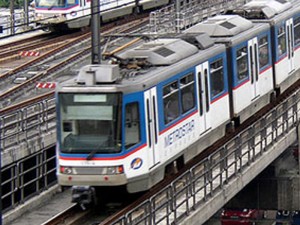
The Manuel V. Pangilinan-led infrastructure holding firm, Metro Pacific Investments Corp. (MPIC), and conglomerate Ayala Corp.—which earlier this year formed an “exclusive” alliance to pursue Light Rail Transit (LRT) projects in greater Metro Manila—submitted the new MRT3 proposal to the Department of Transportation and Communications (DOTC) on August 29, MPIC president Jose Ma. Lim told reporters.
Apart from getting the Ayalas onboard, the new proposal amends a previous framework submitted by MPIC for consideration by the DOTC, which is now under Secretary Joseph Emilio Abaya.
Being an unsolicited proposal, Lim said the legal framework for this proposal was a bit different from MPIC’s previously suggested blueprint. He said this would respect existing contracts governing the operation of the 16.9-kilometer railway that runs from North Avenue in Quezon City to Taft Avenue in Pasay City.
Previous offer, fare hike
In its previous offer submitted in 2011, MPIC asked to be given rights to manage the train line until 2040, extending MRT’s current build-operate-transfer contract by 15 more years.
The company said it would raise fares to P30, or double the current maximum rate of P15 for a one-way, end-to-end trip.
Because current fares are not enough, the government allocates a subsidy of at least P55 for every train passenger on the MRT train to cover power consumption, general maintenance and other overhead costs. This adds up to about P7 billion a year, the DOTC said.
“In the first proposal, it’s the assumption of the existing contracts. We will take over the company and expand it under the rights,” Lim said on the sidelines of the Shareholders’ Association of the Philippines membership meeting.
New concession
“Under this one, we leave it to DOTC to give us a new concession overlaying the existing contracts. It would also allow the government to expand the capacity earlier,” Lim said. “It’s more flexible in the sense that it allows the government to increase the capacity as quickly as possible for the benefit of the public.”
Asked whether this new proposal would interconnect with the existing LRT Line 1 from Monumento to Baclaran, Lim said “it was not specifically emphasized but it was the intention to integrate it” to complete the railway loop.
For his part, Ayala Corp. managing director Eric Francia said in a text message to the Inquirer on Sunday: “This proposal entails adjustments to MPIC’s original submission and still involves capacity expansion. This initiative, should it flourish, would fall within our rail joint venture.”
Fil-Estate
MPIC obtained a foothold in MRT3 after signing a “cooperation” agreement with the Fil-Estate group and others to either buy their shares or take over their voting rights, giving it an equity control of at least 48 percent and voting rights of more than 70 percent in the concession.
The Fil-Estate-led consortium, however, no longer holds economic rights to MRT3 as the cash flow from the railway had been committed to creditors under a securitization deal. The bulk of the debt papers of Metro Railway Transit Corp. (MRTC), which holds the build-lease-transfer contract on MRT3, is held by the state-owned Development Bank of the Philippines (DBP) and Land Bank of the Philippines.
MPIC has long been interested in taking over the MRT3 concession, beginning with a partnership with the Fil-Estate group, the lead MRT3 proponent which, however, no longer has economic rights to its cash flows.
Under the old proposal, MPIC sought to create new cash flows by doubling the capacity of MRT3. The group sought a 30-year MRT3 concession, which is estimated to require $650 million in investment, of which $300 million will be in equity contribution for the expansion of railway capacity and $350 million for the acquisition of equity and some of the bonds issued by MRTC.
Buy out DBP and Landbank
Part of the earlier proposal was to buy out the interest held by DBP and Landbank, which own a combined 22 percent of equity in the MRT3 project but 75 percent of economic rights through bondholders.
The former DOTC chief, Manuel Roxas, who was recently named interior and local government secretary to fill the void left by the late Jesse Robredo, preferred that the MRT3 concession be bid out.
Swiss challenge
If and when the DOTC accepts the MPIC-Ayala framework as an unsolicited proposal, it will be subjected to a “Swiss” challenge, which means other bidders will have the chance to top its offer but as original proponent, the tandem will have the right to match the best offer.
MPIC sees room to double the capacity of the MRT3 system to 700,000 passengers a day from the current 350,000 with the purchase of new cars, upgrading of signaling equipment, improving the frequency of train departures and lengthening the number of cars per train.
For its part, the Ayala group has expressed interest in reinvesting in MRT3 even before establishing an alliance with MPIC. Its property unit, Ayala Land Inc., used to be a minority stakeholder in the railway consortium.
10 rail projects
The MRT3 system is just one of the 10 potential railway projects in Metro Manila that the newly created alliance between the Metro Pacific and Ayala groups want to participate in. The tandem is also bidding for the Light Railway Transit 1 extension project (from Baclaran to Cavite), which is included in the government’s public-private partnership pipeline for this year.
The 10 railway projects refer to a master plan made by the DOTC for rail lines in Metro Manila.
Although bitter rivals in the telecommunications business, both the Pangilinan and the Ayala groups teamed up for railway projects, leveraging their track record in running public utilities such as water infrastructure services as well as toll road operations and management. With a report from Paolo Montecillo

